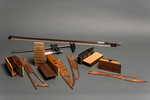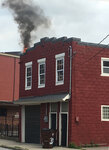We may receive a commission when you use our affiliate links. However, this does not impact our recommendations.
Whenever I explain how “ripple moulding” is made by a “waving engine” – a circa 17th-century machine – most woodworkers are skeptical. First, they are skeptical that ripple moulding, which has all but disappeared, could be beautiful. And in many cases they are skeptical that it even exists.
OK, let’s back up. What is “ripple moulding” or even a “waving engine?” Basically, ripple moulding is an undulating surface that can look like a basket weave or waves on the ocean. Once you see it, you wonder how it could be produced in the 17th century (or perhaps earlier) without CNC or routers. In fact, even modern CNC would have difficulty producing many waving patterns.
So how were they made? Waving engines. Waving engines were human-powered machines that scraped long sticks of mouldings. And, like many modern router tables or CNC, these engines were guided by a pattern to create the accurate and repeatable details.
André Felébien and Joseph Moxon – two of the earliest people to write about the craft of woodworking – both described waving engines in their 17th-century books. But by the late 18th century, A.J. Roubo lamented that the waving engines had disappeared and he couldn’t find one in France to describe for his book “l’Art du menuisier.”
Several modern woodworkers have become fascinated with waving engines and have built replicas (check out this article by J. Thornton). Yannick Chastain has built one. And Don Williams is working on one as well.
But what does the ripple moulding look like? You can find some examples online, but it’s best to see it in person. It’s mesmerizing and intoxicating. The detail can be incredible and the workmanship of many ripple mouldings outshines the paintings that the mouldings usually frame.
When my wife and I visited Holland, Mich., recently, the history museum had a particularly fine example of ripple moulding around the painting “Equestrian Portrait of Prince Frederik Hendrik” by Pauwels van Hillegaert. The painting is circa 1630-1635. While the painting was good (love the horse), the moulding was spectacular. Really really fine.
I’ve seen lots of examples of ripple mouldings, but seeing this particularly crisp example made me think: Perhaps I should make a waving engine…. Luckily my wife was there and mentioned I still needed to hang the dang storm door at the front of our house.
Touché, my love.
— Christopher Schwarz
Here are some supplies and tools we find essential in our everyday work around the shop. We may receive a commission from sales referred by our links; however, we have carefully selected these products for their usefulness and quality.













